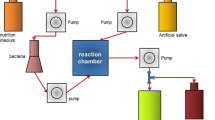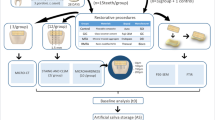Abstract
Objectives
This study is aimed at evaluating the effect of a new glass ionomer cement (GIC) containing fluoro-zinc-silicate fillers on biofilm formation and ion incorporation.
Materials and methods
Streptococcus mutans biofilms were developed on two GIC materials: Caredyne Restore (CD) and Fuji VII (FJ); and hydroxyapatite (HA) for 24 h at 37 °C using a flow cell system. The morphological structure and bacterial viability were analyzed using a confocal laser scanning microscopy. Bacterial adhesion during the initial 2 h was also assessed by viable cell counting. To study the ion incorporation, restored cavities prepared on the root surfaces of human incisors were subjected to the elemental mapping of the zinc and fluoride ions in the GIC-dentin interface using a wavelength-dispersive X-ray spectroscopy electron probe microanalyzer.
Results
Morphological observations revealed that biofilm formation in the CD group was remarkably inhibited compared with the HA and FJ groups, exhibiting sparse, thinner biofilm clusters. The microorganisms adhering to the CD group were significantly inhibited, revealing 2.9 ± 0.4 for CD, 4.9 ± 0.2 for FJ, and 5.4 ± 0.4 log colony-forming units (CFU) for HA. The CD zinc ion incorporation depth was 72.2 ± 8.0 μm. The fluoride penetration of CD was three times deeper than that of FJ; this difference was statistically significant (p < 0.05).
Conclusions
Enhanced by the incorporation of zinc and fluoride ions, the new GIC inhibited biofilm formation by interfering with bacterial adhesion.
Clinical relevance
A novel GIC comprised of fluoro-zinc-silicate fillers may improve clinical outcomes, such as root caries and minimally invasive dentistry.





Similar content being viewed by others
References
Oliva A, Della Ragione F, Salerno A, Riccio V, Tartaro G, Cozzolino A, D’Amato S, Pontoni G, Zappia V (1996) Biocompatibility studies on glass ionomer cements by primary cultures of human osteoblasts. Biomaterials 17:1351–1356
Forsten L (1998) Fluoride release and uptake by glass-ionomers and related materials and its clinical effect. Biomaterials 19:503–508
Sidhu SK, Nicholson JW (2016) A review of glass-ionomer cements for clinical dentistry. J Funct Biomater 7:16. https://doi.org/10.3390/jfb7030016
Frencken JE, Leal SC, Navarro MF (2012) Twenty-five-year atraumatic restorative treatment (ART) approach: a comprehensive overview. Clin Oral Investig 16:1337–1346
Frencken JE (2017) Atraumatic restorative treatment and minimal intervention dentistry. Br Dent J 223:183–189
Momoi Y, Hayashi M, Fujitani M, Fukushima M, Imazato S, Kubo S, Nikaido T, Shimizu A, Unemori M, Yamaki C (2012) Clinical guidelines for treating caries in adults following a minimal intervention policy—evidence and consensus based report. J Dent 40:95–105
Liao Y, Brandt BW, Li J, Crielaard W, Van Loveren C, Deng DM (2017) Fluoride resistance in Streptococcus mutans: a mini review. J Oral Microbiol 9:1344509
Wiegand A, Buchalla W, Attin T (2007) Review on fluoride-releasing restorative materials—fluoride release and uptake characteristics, antibacterial activity and influence on caries formation. Dent Mater 23:343–362
Marquis RE (1995) Antimicrobial actions of fluoride for oral bacteria. Can J Microbiol 41:955–964
Hahnel S, Ionescu AC, Cazzaniga G, Ottobelli M, Brambilla E (2017) Biofilm formation and release of fluoride from dental restorative materials in relation to their surface properties. J Dent 60:14–24
Chau NP, Pandit S, Cai JN, Lee MH, Jeon JG (2015) Relationship between fluoride release rate and anti-cariogenic biofilm activity of glass ionomer cements. Dent Mater 31:e100–e108
De Fúcio SB, Puppin-Rontani RM, de Carvalho FG, Mattos-Graner Rde O, Correr-Sobrinho L, Garcia-Godoy F (2009) Analyses of biofilms accumulated on dental restorative materials. Am J Dent 22:131–136
Sousa RP, Zanin LC, Lima JP, Vasconcelos SM, Melo MA, Beltrão HC, Rodrigues LK (2009) In situ effects of restorative materials on dental biofilm and enamel demineralization. J Dent 37:44–51
Najeeb S, Khurshid Z, Zafar MS, Khan AS, Zohaib S, Martí JM, Sauro S, Matinlinna JP, Rehman IU (2016) Modifications in glass ionomer cements: nano-sized fillers and bioactive nanoceramics. Int J Mol Sci 17:1134
Dashper SG, Catmull DV, Liu SW, Myroforidis H, Zalizniak I, Palamara JE, Huq NL, Reynolds EC (2016) Casein phosphopeptide-amorphous calcium phosphate reduces Streptococcus mutans biofilms development on glass ionomer cement and disrupts established biofilms. PLoS One 11:e0162322
Ibrahim MA, Neo J, Esguerra RL, Fawzy AS (2015) Characterization of antibacterial and adhesion properties of chitosan-modified glass ionomer cement. J Biomater Appl 30:409–419
Yan H, Yang H, Li K, Yu J, Huang C (2017) Effects of chlorhexidine-encapsuled mesoporous silica nanoparticles on the anti-biofilm and mechanical properties of glass ionomer cement. Molecules 22:1225
Hook ER, Owen OJ, Bellis CA, Holder JA, O’Sullivan DJ, Barbour ME (2014) Development of a novel antimicrobial-releasing glass ionomer cement functionalized with chlorhexidine hexametaphosphate nanoparticles. J Nanobiotechnol 12:3
Hu J, Du X, Huang C, Fu D, Ouyang X, Wang Y (2013) Antibacterial and physical properties of EGCG-containing glass ionomer cements. J Dent 41:927–934
Topcuoglu N, Ozan F, Ozyurt M, Kulekci G (2012) In vitro antibacterial effects of glass-ionomer cement containing ethanolic extract of propolis on Streptococcus mutans. Eur J Dent 6:428–433
Elsaka SE, Hamouda IM, Swain MV (2011) Titanium dioxide nanoparticles addition to a conventional glass-ionomer restorative: influence on physical and antibacterial properties. J Dent 39:589–598
Publication number: WO/2017/168836, WO/2017/168837
He G, Pearce EI, Sissons CH (2002) Inhibitory effect on ZnCl(2) on glycolysis in human oral microbes. Arch Oral Biol 47:117–129
Koo H, Sheng J, Nguyen PT, Marquis RE (2006) Co-operative inhibition by fluoride and zinc of glucosyl transferase production and polysacharide synthesis by mutans streptococci in suspension cultures and biofilms. FEMS Microbiol Lett 254:134–140
Hengtrakool C, Pearson GJ, Wilson M (2006) Interaction between GIC and S. sanguis biofilms: antibacterial properties and changes of surface hardness. J Dent 34:588–597
Takenaka S, Oda M, Domon H, Ohsumi T, Suzuki Y, Ohshima H, Yamamoto H, Terao Y, Noiri Y (2016) Vizantin inhibits bacterial adhesion without affecting bacterial growth and causes Streptococcus mutans biofilm to detach by altering its internal architecture. Biochem Biophys Res Commun 480:173–179
Wakamatsu R, Takenaka S, Ohsumi T, Terao Y, Ohshima H, Okiji T (2014) Penetration kinetics of four mouthrinses into Streptococcus mutans biofilms analyzed by direct time-lapse visualization. Clin Oral Investig 18:625–634
Ohsumi T, Takenaka S, Wakamatsu R, Sakaue Y, Narisawa N, Senpuku H, Ohshima H, Terao Y, Okiji T (2015) Residual structure of Streptococcus mutans biofilm following complete disinfection favors secondary bacterial adhesion and biofilm re-development. PLoS One 10:e0116647
Ngo HC, Mount G, Mclntyre J, Do L (2011) An in vitro model for the study of chemical exchange between glass ionomer restorations and partially demineralized dentin using a minimally invasive restorative technique. J Dent 39(Suppl 2):S20–S26
Hotta M, Li Y, Sekine I (2001) Mineralization in bovine dentin adjacent to glass-ionomer restorations. J Dent 29:211–215
Han L, Okiji T (2011) Evaluation of the ions release / incorporation of the prototype S-PRG filler-containing endodontic sealer. Dent Mater J 30:898–903
Sakaue Y, Takenaka S, Ohsumi T, Domon H, Terao Y, Noiri Y (2018) The effect of chlorhexidine on dental calculus formation: an in vitro study. BMC Oral Health 18:52
Padovani GC, Fúcio SB, Ambrosano GM, Correr-Sobrinho L, Puppin-Rontani RM (2015) In situ bacterial accumulation on dental restorative materials. CLSM/COMSTAT analysis. Am J Dent 28:3–8
Carey CM, Spencer M, Gove RJ, Eichmiller FC (2003) Fluoride release from a resin-modified glass-ionomer cement in a continuous-flow system. Effect of pH. J Dent Res 82:829–832
Ngo HC, Mount G, Mc Intyre J, Tuisuva J, Von Doussa RJ (2006) Chemical exchange between glass-ionomer restorations and residual carious dentine in permanent molars: an in vivo study. J Dent 34:608–613
Zoergiebel J, llie L (2013) Evaluation of a conventional glass ionomer cement with new zinc formulation: effect of coating, aging and storage agents. Clin Oral Investig 17:619–626
Molina GF, Cabral RJ, Mazzola I, Lascano LB, Frencken JE (2013) Mechanical performance of encapsulated restorative glass-ionomer cements for use with atraumatic restorative treatment (ART). J Appl Oral Sci 21:243–249
Lynch RJ, Churchley D, Butler A, Keams S, Thomas GV, Badrock TC, Cooper L, Higham SM (2011) Effects of zinc and fluoride on the remineralization of artificial carious lesions under simulated plaque fluid conditions. Caries Res 45:313–322
Lippert F (2012) Dose-response effects of zinc and fluoride on caries lesion remineralization. Caries Res 46:62–68
Gu H, Fan D, Gao J, Zou W, Peng Z, Zhao Z, Ling J, LeGeros RZ (2012) Effect of ZnCl2 on plaque growth and biofilm vitality. Arch Oral Biol 57:369–375
Funding
This work was supported, in part, by Grant-in-Aid for Scientific Research (grant no. 15H05021) from the Japan Society for the Promotion of Science. This work was also partially supported by the Mitsubishi Foundation and GC Corporation, Tokyo, Japan.
Author information
Authors and Affiliations
Corresponding author
Ethics declarations
Conflict of interest
This research is partially supported by GC Corporation (supplies expenses and publication fee).
Ethical approval
All of the experimental protocols involving the donation of an extracted tooth were approved by the Niigata University Ethics Committee.
Informed consent
Informed consent was obtained from all individual participants included in the study.
Disclaimer
The sponsor had no control for the interpretation, writing, or publication of this work.
Additional information
Publisher’s note
Springer Nature remains neutral with regard to jurisdictional claims in published maps and institutional affiliations.
Electronic supplementary material
Supplementary Fig S1
Flow cell system for biofilm formation. The flow cell system consisted of a medium reservoir, a peristaltic pump, and a carboy for waste. Two specimens were placed at either end so that the fluid flow did not interfere. (JPG 587 kb)
Supplementary Fig S2
Flow cell system for bacterial adhesion test. During the operation time, fresh media was constantly delivered to the bacterial suspension to maintain optimal density. (JPG 311 kb)
Rights and permissions
About this article
Cite this article
Hasegawa, T., Takenaka, S., Ohsumi, T. et al. Effect of a novel glass ionomer cement containing fluoro-zinc-silicate fillers on biofilm formation and dentin ion incorporation. Clin Oral Invest 24, 963–970 (2020). https://doi.org/10.1007/s00784-019-02991-0
Received:
Accepted:
Published:
Issue Date:
DOI: https://doi.org/10.1007/s00784-019-02991-0




